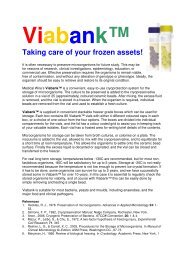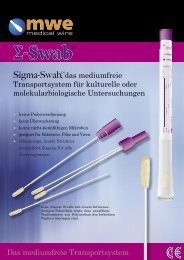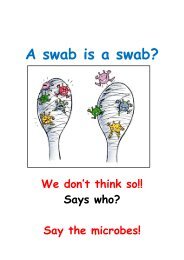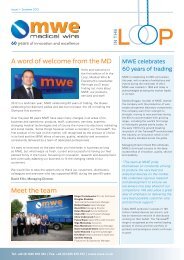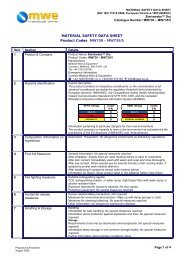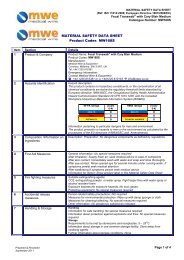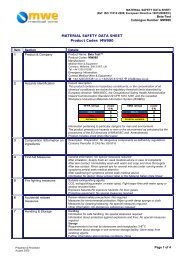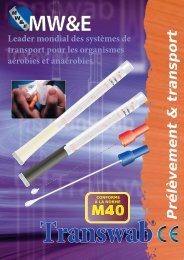Material Improvement.indd - MWE - Medical Wire
Material Improvement.indd - MWE - Medical Wire
Material Improvement.indd - MWE - Medical Wire
Create successful ePaper yourself
Turn your PDF publications into a flip-book with our unique Google optimized e-Paper software.
which will absorb a much larger sample, typically 70-80μl,similar to a standard fi bre bud. Indeed the latest materialcan absorb more than 125μl, while retaining the ability tomaintain microorganisms in a viable condition for at least48 hours (and in practice much more). Our own, andindependent studies have shown these new materials tobe entirely suitable for specimen collection and transport,and it is on the basis of these developments that we havelaunched both Σ-Swabs® & Σ-Transwabs®.<strong>Medical</strong> <strong>Wire</strong> has also investigated fl ock swabs. We do haveaccess to fl ock, but feel there are issues which mean it isnot yet ready to use for specimen collection, not least ofwhich is the issue of patient and healthcare worker safety.Flocking technology has been around for many years.You may be familiar with it in as the lining of your carglove box, or on expensive wallpaper. The problem is thatmany of the microfi bers are not captured by the underlyinglayer of glue, and remain loose. These microfi bers are ofrespirable size, and can present a hazard, even on theirown 3 . The manufacturers take care to remove as many ofthese microfi bers as possible, but some remain. If you havesome fl ock swabs you can demonstrate this by rubbing orgently fl icking them over a glass surface. It is particularlynoticeable on the coated fl ock swabs supplied with sometransport swab devices. The risk of disease (Flock Worker’sLung) is known within the fl ocking industry, although it cantake some years to become manifest. But the combinationof loose, respirable microfi bers and particles, and infectiouspathogens creates a new potential hazard which has yet tobe accounted for.the coating apparent on the fl ock fi bers in certain transportdevices seems to contribute to overgrowth when samplesare carried at ambient temperatures.In a new study 4 , polyurethane foam tipped swabs (Σ-Swabs ® )recovered signifi cantly more bacteria of all types than nylonfibre fl ocked swabs (Copan).For now, advanced hydrophilic polyurethane foams, asused on Σ-Swabs ® & Σ-Transwabs ® , are the best materialfor the collection and integrity of the specimen, and optimumperformance in the laboratory, whether automated orconventional.Results (independent) for MRSA release & recovery usingadvanced polyurethane foam tipped swabs with standardsize buds (Sigma Dry Swab)Average swab absorption (microlitres of saline) 125.60h 24h 48hMRSA RT 3.86x10 6 cfu/ml 2.99x10 7 cfu/ml 4.21x10 7 cfu/mlMRSA 4 O C 3.86x10 6 cfu/ml 9.08x10 6 cfu/ml 7.86x10 6 cfu/mlResults are within the parameters of CLSI M40, with limitedloss or growth, even at ambient temperature.References1.2.3.4.Inverarity, D., M. Diggle, G. Edwards, & T. Mitchell, 2006, An Evaluationof Media Suitable for the Transportation by Air of Streptococcuspneumoniae. Federation of Infection Societies Conference, CardiffCLSI, 2003, Quality Control of Microbiological Transport Systems:Approved Standard CLSI Document M40-AKern, D.G. et al, 1998, Flock Worker’s Lung: Chronic Interstitial LungDisease in the Nylon Flocking Industry, Annals of Internal Medicine(American College of Physicians), 129, 261-272Turner, J., et al, 2010, The Characterization of the Absorption andRelease Properties of Various Clinical Swab Types. Poster T89, 26thClinical Virology Symposium, Daytona Beach, US.Flock swab surfacePerformance, too, has some questions. We have all heard themyth of the neatly arranged perpendicular fi bers. The realityis somewhat different, as can be seen in the photograph.There is no doubt that the fl ocking creates a large surfacearea, and that the swab picks up a large specimen. Butwww.mwe.co.ukDon’t just go with the flock!



